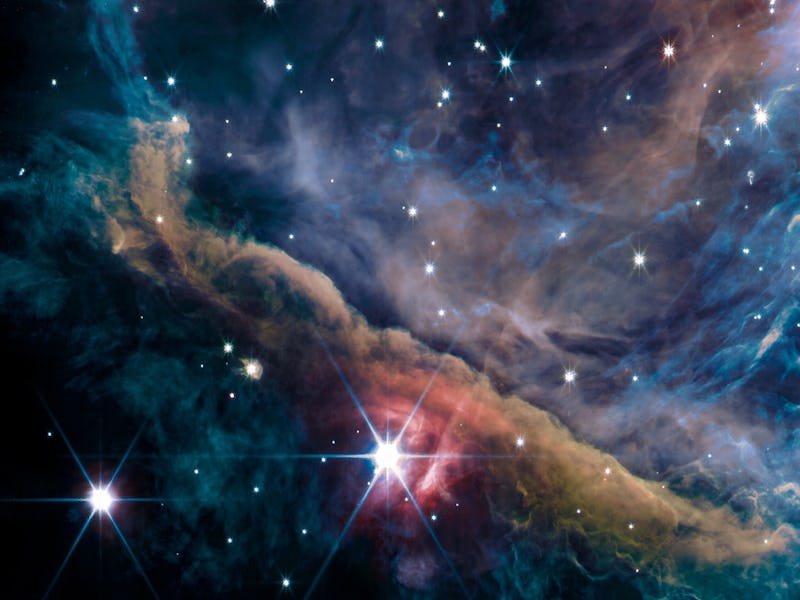Look! This new Webb Telescope picture of the beloved Orion Nebula is glorious
Webb takes us inside a nearby nebula to shed light on the mysteries of star formation in the recent universe.

The James Webb Space Telescope spent part of its weekend studying a fascinating inner region of the Orion Nebula.
Orion is a familiar constellation in the night sky, recognizable by the “belt” of three stars at its waist and the red glow of (eventually) doomed Betelgeuse at its left shoulder. A starry “sword” hangs from Orion’s belt, and the large, bright star near the tip of the sword isn’t actually a star — it’s a whole nebula, a cloud of gas, dust, and newborn stars, 24 light years wide and 1,300 light years away. Because it’s the nearest major star-forming region to Earth, it’s a hotspot for astronomers interested in how stars are born.
The newest Webb image, a composite of several images taken through 11 different filters on the telescope’s Near InfraRed Camera, or NIRCam, takes on a tour of the Orion Bar — a radiation-blasted wall in the heart of the nebula, where young stars are sculpting the nebula with stellar wind and ultraviolet rays.
This Webb Space Telescope image of an inner region of the Orion Nebula combines images taken with 11 NIRCam filters.
A wall of dense gas and dust cuts across the image from the upper left to the lower right, forming a bastion against the bombardment of ultraviolet radiation from the cluster of massive stars blazing away in the upper right corner: the Trapezium Cluster. This battered cosmic wall, besieged by the Trapezium Cluster, is called the Orion Bar, and the stars’ radiation is slowly eroding it, carving out cavities around the pillars and filaments of denser material.
That relentless onslaught of stellar energy is also changing the Orion Bar on a much smaller scale. Physicists call areas like the Orion Bar “photo-dissociation regions,” because stellar radiation (“photo-”) breaks apart molecules (“dissociation”) and strips away electrons from atoms.
The edge facing the Trapezium Cluster catches the full force of the young stars’ energetic bombardment. Here, the ultraviolet radiation is strong enough to knock the electrons off hydrogen atoms, leaving behind a cloud of ionized hydrogen gas (a bunch of protons, in other words). Further back, the front layers of the cloud offer some protection, but there’s still too much energy pouring in to allow the hydrogen atoms to pair off and form molecules. That doesn’t happen until much deeper in the Orion Bar.
The Keck Observatory in Hawai'i recently released its own image of this region.
Touring the Orion Bar
Several key features, including newborn stars and interstellar gas and dust filaments, are labelled in this Webb Space Telescope image of the Orion Bar.
The filters used to make this image each captured different wavelengths of light emitted by ionized gas, molecular gas, dust, and hydrocarbons (which tend to form on interstellar dust grains). That means we can see several long, sinuous filaments rich in molecular hydrogen and hydrocarbons, near the lower right. We can also spot at least two very young stars: one with a planetary disk — a collection of dust, ice, and gas which will one day coalesce into planets — forming around it, and another still embedded in the cloud of gas and dust that formed it.
Webb vs. Hubble
A Hubble Space Telescope image (left) and a Webb Space Telescope image (right) of the same section of the Orion Nebula.
Those details are visible because Webb’s infrared cameras view the universe in longer wavelengths of light than our eyes can see. In the infrared, Webb can see through the dense layers of interstellar dust that would normally block the view of an optical telescope like Hubble. Infrared is also good at seeing cooler material, like molecular hydrogen. That gives astronomers a better view of the inside of the nebula, where most of the real action is happening.
In a Hubble image of the same part of the Orion Nebula, the side of the Orion Bar facing the radiation from the Trapezium cluster glows brightest thanks to the ionized hydrogen — when an electron gets stripped away, energy is released, making the gas cloud glow.
This article was originally published on